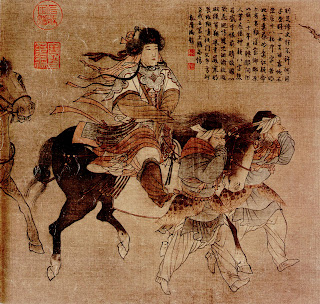
(傳)張瑀 文姬歸漢圖 吉林博物館藏
繪畫中出現女性,大致可以概括為三種情形,一為替特定對象寫真的肖像畫;二為不詳畫中人物身份背景的美人畫;此外即為以歷史或傳說中人物為素材的人物故事畫。
在女性人物故事畫中,經常被圖繪者,蓋為王昭君、蔡文姬、楊貴妃。這三位中國歷史上的名女人之所以受到畫家的青睞,不僅僅是其傳奇色彩濃厚、家喻戶曉的生平事蹟,能夠達到雅俗共賞的效果;對於具有知識水平的觀畫者而言,這三位女子本來就是富含爭議,話題性很強的角色,在詠史抒懷的文學作品中頻繁現身。
本文以王昭君與蔡文姬的歷代圖象及題詠為例,探討其間形象重疊與交錯的現象,闡述古人觀畫而寄寓情志,賦予賞心悅目的女性圖象高尚的思想內涵,使觀畫的視覺行為具有「好好色」之餘的道德指標。
《婦研縱橫》74期(2005年4月),頁1-16。
Iconological Study in Pictures of Wang Zhao Jun and Cai Yan
There can be three instances where female figures will be portrayed in paintings. One will be drawing a specific person of interest, secondly the drawing of an unknown beauty and the third will be painting a fictional character or a historical figure.
Wang Zhao Jun, Cai Wen Ji and Yang Gui Fei were the painters’ favorites out of all the female figures. These three famous women had remarkable backgrounds and they had spurned much controversy thus they were often the topic in several literary works.
This article aims to use the images and colophons for Wang Zhao Jun and Cai Wen Ji as an example for discussions on the scenario of overlapping images. The article further elaborates on how people from the ancient times added feelings as another element to interpret their paintings. This element would subsequently create a moral indicator for “appreciating the beauty”.










沒有留言:
張貼留言